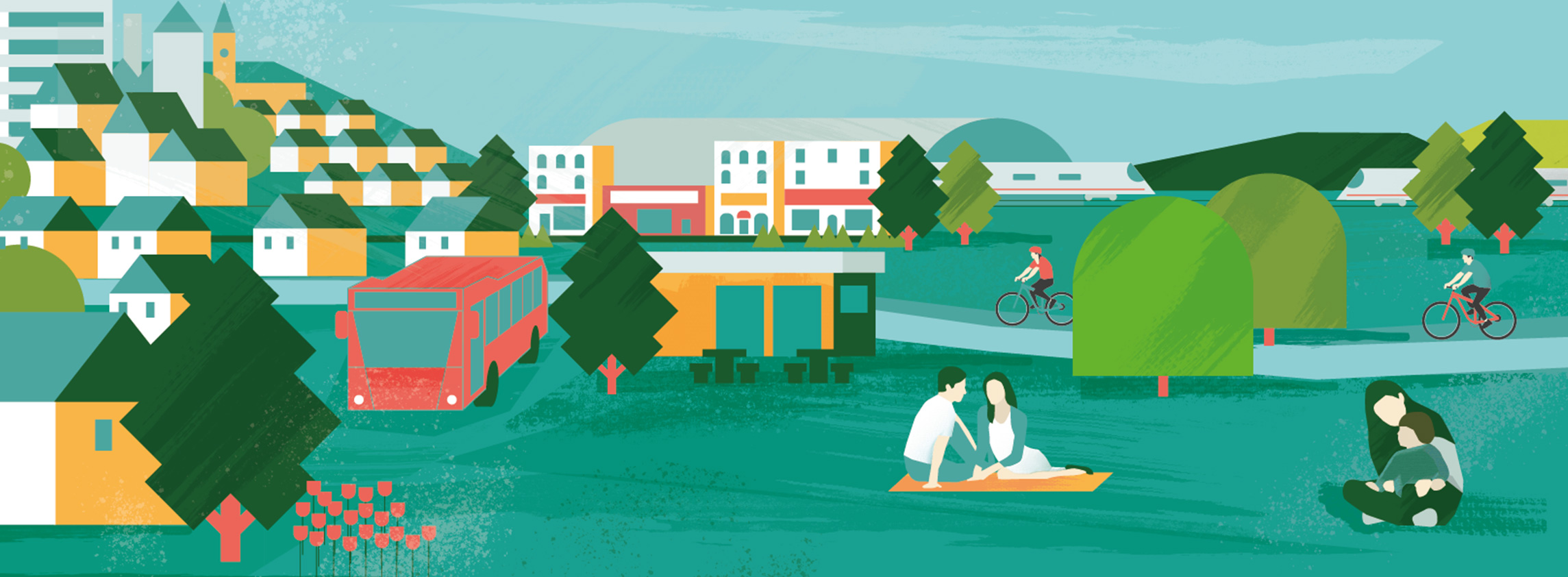If the planning system hopes to achieve the sustainability goals set out in the NPPF, a more strategic approach is needed
Our previous planning research has focused mainly on plan-making progress, the number of consents for new homes being granted, and the speed at which they are built out. However, the volume of delivery is not the only criterion that the planning system can be judged on. The NPPF sets out the goal of “contributing to the achievement of sustainable development.”
This gives the planning system economic, social and environmental objectives, to create places that support growth and productivity, form strong communities and protect and enhance the environment. With the UK required under the Paris Agreement to reach net zero carbon by 2050, radical emissions reductions are ever more necessary. Planning has a central role in delivering these objectives by ensuring that new development supports sustainable settlement patterns, aligns with economic growth, and makes best use of existing public transport infrastructure.
These objectives are taking on a new urgency in this the first year of the ‘Decade of Action’ that the UN has announced to deliver Sustainable Goals by 2030. Momentum on these goals is evident in some of the post-Covid announcements made by city authorities around the world, most notably the ’15-minute city’ concept announced by the Mayor of Paris and which aims to encourage more self-sufficient communities within each arrondissement of the French capital, with grocery shops, parks, cafes, sports facilities, health centres, schools and even workplaces just a walk or bike-ride away.
Our research shows that the UK planning system is not currently achieving these sustainable objectives. There is little relationship between employment growth and where new homes are being consented, and sites are frequently located far from existing public transport links. More thought needs to be given to the design and delivery of homes to ensure residential development is both economically and environmentally sustainable.
Meeting economic objectives
Housebuilding should be sustainable and contribute to the delivery of high-quality places. A key feature of sustainable development is that which meets the economic goals of a given area. This is an issue that was recently explored in the Inspector’s Post Hearing Letter in relation to the shared Spatial Strategy for the North Essex Authorities. In his letter the Inspector acknowledged that migration data showing the relative strength of local economies did justify a differential in the apportion of the housing requirement. Despite this, areas with the highest level of planned housing delivery rarely align with the highest rates of economic growth.
The chart below shows the differences between those local authorities with a high level of employment and those with the highest relative volumes of full planning consents granted for new homes. Of 317 local authorities across England, only 7% fall into the highest group within both of these categories. Of the areas with the greatest levels of residential development planned, just 29% are also recording the highest volumes of employment.
Thought needs to be given, then, to development that is designed to encourage sustainable access between places to live and places to work and thereby reduce lengthy commuter journeys. Urban areas have sufficient infrastructure and capacity to support high volumes of employment. Across England, towns and cities are the locations with the highest jobs density. The high rates of employment also drive a demand for office and industrial space, meaning these areas can be restricted in terms of the availability and cost of land for residential development. This often drives the delivery of high-density residential solutions; often focused at a similar price point and target market. More varied solutions, as recommended by the Letwin Report, for new homes can often only be delivered outside of these dense urban areas.
Of the areas with the greatest levels of residential development planned, just 29% also have the highest volumes of employment
Savills Research
The disparity isn’t just between current employment levels and future planned residential delivery. Historic growth in employment has consistently been at odds with the provision of residential consents, and the correlation found between the two factors is very weak among local authorities across England.
Areas like Cheltenham, City of London and Solihull, with the strongest rates of employment and employment growth will rely on workers from adjacent areas of Tewkesbury, Tower Hamlets and Warwick respectively, all of which have demonstrated a strong commitment to housing growth in recent years. This highlights the importance of strategic planning beyond local authority level, that recognises such relationships between economic centres and those ‘donor neighbours’ that contribute towards housing demand. This also requires the delivery of the infrastructure that enables both physical and virtual connectivity.
Improving environmental outcomes
If development cannot be aligned with employment centres due to constrained land availability, the planning system should focus on ensuring that travel between residential and employment locations is as sustainable as possible. Public transport is the most obvious solution for sustainable movement. Research from the Department for Business, Energy and Industrial Strategy (BEIS) has looked into variation in carbon emissions per passenger per km travelled for a range of different modes of transport. The research found that emissions from a single person car journey were over four times that of a domestic rail service.
Despite this, the most recent evidence from the Department for Transport shows that 68% of workers in Great Britain still typically use a car to travel to work, with trains (10%), walking (10%) and buses (7%) making up the majority of the remaining commuters. Clearly, this is not a challenge that can only be solved by new development.
However, our research shows that there is much more that could be done in planning to deliver new major residential development in sustainable locations. Between 2015 and 2019, less than 50% of homes gaining full consent were within a one-mile radius of a train or underground station, and 6% were over five miles from a station. This type of development is likely to encourage private car use, particularly if the development does not include retail or leisure amenities.
Between 2015 and 2019, less than 50% of homes gaining full consent were within a one mile radius of a train or underground station
Savills Research
Our analysis shows that sites gaining consent at a greater distance to existing settlements and infrastructure are more likely to be smaller in size. Of all sites gaining full consent over five miles from an existing train station, 75% had capacity for fewer than 100 homes. Similarly, over half of sites achieving consent over one kilometre from an existing urban settlement had capacity for fewer than 50 homes.
These are likely to be locations where it is challenging to provide frequent and affordable public transport; Department for Transport data shows that those living in rural villages or hamlets travelled on average three times as many miles per year by private car as those living in urban locations. If development cannot be located either near employment centres or existing public transport links, the planning system needs to prioritise delivering developments that are at a scale that can support either on-site, walkable amenities or new public transport links.
Case study
A prime case study of these challenges is in Oxfordshire. High jobs density can be found in the key urban centres of Banbury, Didcot and Oxford, as shown in darkest red on the map below. The area is served well by rail, with London connected to the South West and Midlands via Didcot and Oxford respectively. Oxfordshire is also well equipped for local rail travel, with rail links serving each of the key urban settlements.
Despite the presence of high jobs density and rail connectivity across the county, Didcot is one of the only areas where the number of consents granted over the past five years reflects the provision of jobs and infrastructure, with full consent granted for almost 3,000 homes in the OX11 postcode district alone between 2015 and 2019.
Other areas across Oxfordshire have seen high volumes of consents granted seemingly detached from areas of high employment and connectivity to public transport, suggesting a lower consideration given to economically and environmentally sustainable development.
Heyford Park, to the north-west of Bicester, will deliver 700 homes in an area heavily reliant on private car travel. Similarly, over the past five years, full consent has been granted for almost 2,000 homes in the area directly surrounding Witney. The size and location of consents granted across this area suggest a heavy reliance on the A40 in order to grow successfully.
Through a more coordinated strategic planning approach – led by the Oxfordshire Growth Board – a more sustainable model is beginning to be achieved. This gives a greater focus for the delivery of new housing in and around Oxford – including in the Green Belt – given the concentration of jobs in the city (approximately one-third of all of the jobs in the county are within Oxford). This includes allocations around the new Oxford Parkway station contained in the emerging Cherwell Local Plan and the allocations in the draft South Oxfordshire Local Plan on the southern edge of the Oxford, close to the Cowley branch line, which is a route proposed to be opened to passengers. This approach will achieve a greater alignment between the location of jobs and homes and provide more sustainable transport options for commuters.
Key recommendations
- More effective strategic planning that ensures better integration of planned homes, jobs and infrastructure across boundaries.
- Incentives within the planning system to increase density in the right locations, including mixed-use developments.
- Incentives to encourage sustainable transport and greater recognition of micro-mobility in the larger cities.
- Measures that enhance communications in more rural locations, notably 5G, home working, and micro-business hubs, to reduce the need to travel.

